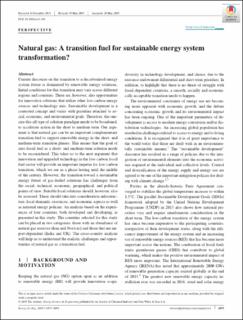| dc.contributor.author | Safari, Amir | |
| dc.contributor.author | Das, Nandini | |
| dc.contributor.author | Langhelle, Oluf | |
| dc.contributor.author | Roy, Joyashree | |
| dc.contributor.author | Assadi, Mohsen | |
| dc.date.accessioned | 2023-02-03T11:24:28Z | |
| dc.date.available | 2023-02-03T11:24:28Z | |
| dc.date.created | 2019-08-04T10:48:25Z | |
| dc.date.issued | 2019 | |
| dc.identifier.citation | Safari, A., Das, N., Langhelle, O., Roy, J., & Assadi, M. (2019). Natural gas: A transition fuel for sustainable energy system transformation?. Energy Science & Engineering, 7(4), 1075-1094. | en_US |
| dc.identifier.issn | 2050-0505 | |
| dc.identifier.uri | https://hdl.handle.net/11250/3048261 | |
| dc.description.abstract | Current discourse on the transition to a decarbonized energy system future is dominated by renewable energy solutions. Initial conditions for this transition may vary across different regions and countries. There are, however, also opportunities for innovative solutions that utilize other low-carbon energy sources and technology mix. Sustainable development is a contested concept and varies with priorities attached to social, economic, and environmental goals. Therefore, the one-size-fits-all type of solution paradigm needs to be broadened, to accelerate action in the short to medium term. Our argument is that natural gas can be an important complementary transition fuel to support renewable energy in the short- and medium-term transition phases. This means that the goal of zero fossil fuel as a short- and medium-term solution needs to be reconsidered. This takes us to the next argument that innovation and upgraded technology in the low-carbon fossil fuel sector will provide an important impetus for low-carbon transition, which we see as a phase lasting until the middle of the century. However, the transition toward a sustainable energy future of gas-fueled solutions has challenges from the social, technical, economic, geographical, and political points of view. Suitable local solutions should, however, also be assessed. These should take into consideration infrastructure, local demands, resources, and economic aspects as well as national energy policies. An analysis based on the experiences of four countries, both developed and developing, is presented in this study. The countries selected for this study can be placed in two categories: those with an abundance of natural gas reserves (Iran and Norway) and those that are import-dependent (India and UK). The cross-country analysis will help us to understand the realistic challenges and opportunities of natural gas as a transition fuel. | en_US |
| dc.language.iso | eng | en_US |
| dc.publisher | Wiley | en_US |
| dc.rights | Navngivelse 4.0 Internasjonal | * |
| dc.rights.uri | http://creativecommons.org/licenses/by/4.0/deed.no | * |
| dc.title | Natural gas: A transition fuel for sustainable energy system transformation? | en_US |
| dc.type | Peer reviewed | en_US |
| dc.type | Journal article | en_US |
| dc.description.version | publishedVersion | en_US |
| dc.rights.holder | The authors | en_US |
| dc.subject.nsi | VDP::Teknologi: 500 | en_US |
| dc.source.pagenumber | 1075-1094 | en_US |
| dc.source.volume | 7 | en_US |
| dc.source.journal | Energy Science & Engineering | en_US |
| dc.source.issue | 4 | en_US |
| dc.identifier.doi | 10.1002/ese3.380 | |
| dc.identifier.cristin | 1713904 | |
| cristin.ispublished | true | |
| cristin.fulltext | original | |
| cristin.qualitycode | 1 | |

